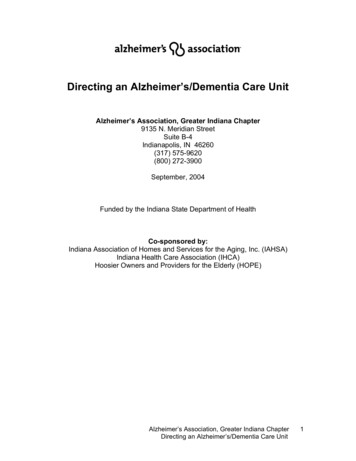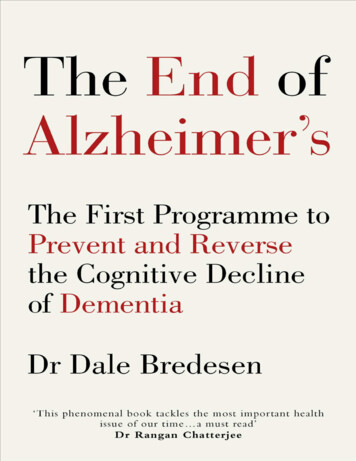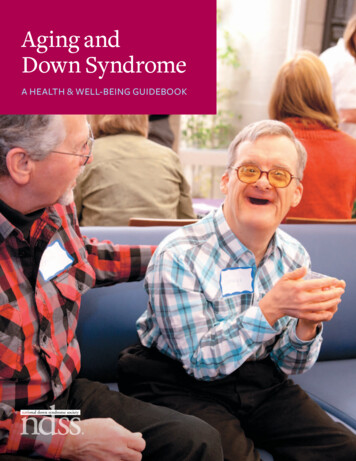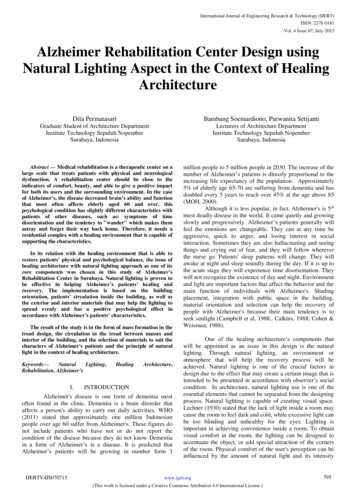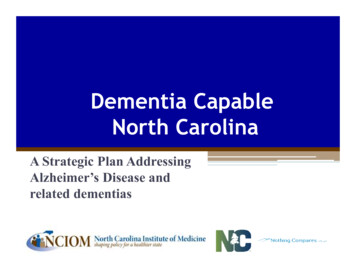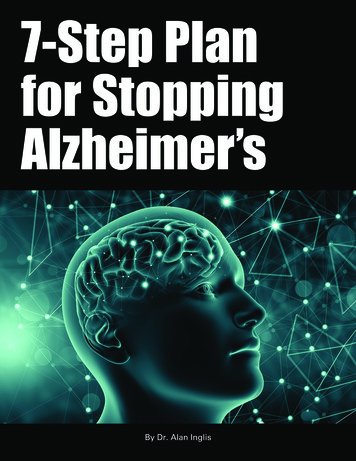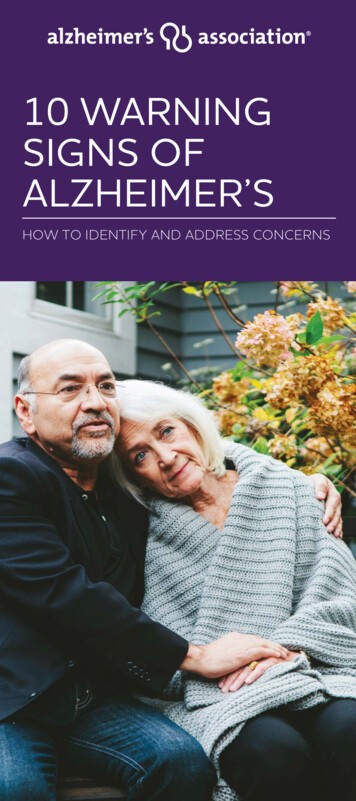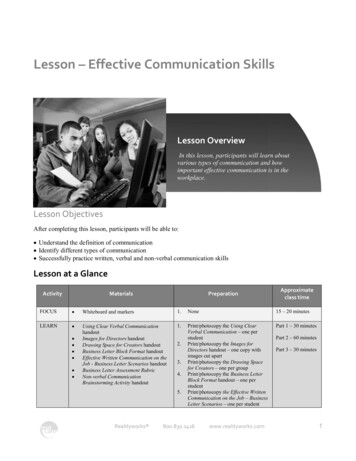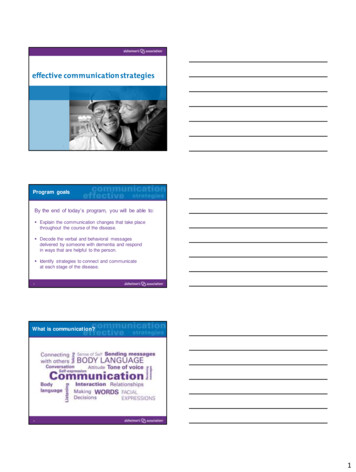
Transcription
effective communication strategies1Program goalsBy the end of today’s program, you will be able to: Explain the communication changes that take placethroughout the course of the disease. Decode the verbal and behavioral messagesdelivered by someone with dementia and respondin ways that are helpful to the person. Identify strategies to connect and communicateat each stage of the disease.2What is communication?31
Communication changes throughout the diseaseEarly stage (Mild) Convey thoughts and feelings through language. Able to make decisions about future care. May misinterpret what others say.Middle stage (Moderate) Use basic words and sentences.Rely more on tone of voice, facial expression and bodylanguage.Continue to need emotional connection and meaningful activity.Late stage (Severe)4 May still respond to familiar words, phrases or songs.Use body language and the five senses to connect.Continue to need emotional connection.Communication in the early stageChanges you may notice include: Difficulty finding the right words. Taking longer to speak or respond. Withdrawing from conversations. Struggling with decision-makingor problem-solving.5Martha Tierney, LCSW, is Associate Director of ResearchVolunteer Programs for the National Office of theAlzheimer ’s Association.662
Communication in the early stageTo connect: Ask directly how to help withcommunication. Keep sentences clear andstraightforward. Leave plenty of time forconversations. Include the person inconversations thataffect him or her, includingplanning for the future.7Communication in the early stageKeep in mind: Avoid making assumptions. Speak directly to the person. Communicate in the way that ismost comfortable for theperson. Options include phone,email, and in person. Laugh together. Be honest, laugh together, andstay connected with each other.8Communication in the middle stageChanges you may notice include: Increased difficulty finding the right words.Using familiar words repeatedly.Inventing new words to describe familiar things.Easily losing train of thought.Speaking less frequently.Communicating through behavior rather than wordsmore often.Consult a doctor when you notice major or suddenchanges.93
Beverly is a caregiver support groupfacilitator whose husband hasAlzheimer ’s disease.10Communication in the middle stageTo connect, approach the person gently Approach from the front, say who youare and call the person by name. Maintain eye contact and get at eyelevel if seated or reclining. Avoid criticizing, correctingand arguing. Pay attention to your tone. Take your time.11Rebecca’s mother had Alzheimer’sdisease.124
Communication in the middle stageTo connect, join the person’s realityKeep respect and empathy in your mind, then: Assess the person’s needs. Let the person know you hear his or her concerns,whether they are expressed through words, behavioror both. Provide a brief answer. Respond to the emotions behind the statement.13Communication in the middle stageTo connect, keep it slow and basic Use short sentences and basic words. Speak slowly and clearly, one person and one questionat a time. Limit distractions. Be patient. Offer a guess or fill in words if acceptable.14Communication in the middle stageTo connect, give multiple cues Provide visual cues and gestures.Avoid sudden movement.Write things down for the person.Put answers into your questions.Repeat as needed.Turn negatives into positives.Avoid quizzing.155
Communication in the middle stageTo connect, respond empathically and reassure Join the person’s reality.Provide reassurance that you hear and understand.Focus on the feelings, not the facts.Validate and redirect the person if necessary.16Communication in the late stageChanges you may notice include: Communication is reduced to a few words or sounds. Possible responses to familiar words or phrases.To connect: Listen for expressions of pain and respond promptly.Help the person feel safe and happy.Continue to bring respect to each conversation.Keep talking.Use all five senses to communicate.17Sandra’s mother is in the late stageof Alzheimer ’s disease.186
Communication in the late stageConnect through touch Feel different fabrics.Identify shapes by touch.Give lotion hand massages.Identify everyday items in abag by touch.Visit with animals.Sculpt usingnon-toxic materials.Hold the person’s hand or strokehis or her arm or back.19Communication in the late stageConnect through sight Laminate brightly colored pictures to look attogether.Watch videos of animals, nature or travel.Look at photo albums together.View photos of famous paintings, favorite settingsor prominent people from the past.Go bird-watching or visit an aquarium.Paint with watercolors.Go outdoors or sit by an open window together.20Communication in the late stageConnect through sound Listen to familiar music.Listen to recordings of the sounds of nature, farms,cities or animals.Identify musical instruments by sound.Listen to songs or speech in the person’s nativelanguage.Read books, poetry, scripture, or newspaperarticles to the person.Let the person hear the gentle tone of your voice.217
Communication in the late stageConnect through smell Make small plastic bags containing items for theperson to smell, such as: Herbs or spices. Cotton balls dipped in essential oils. Grass clippings or fragrant flowers. Teas or coffee beans.Use fragrant lotions for hand massagesCook or feed the person foods that smell good,such as apple pie or chicken soup.22Communication in the late stageConnect through taste Favorite foods.Home-baked goodies.Popsicles.Flavored drinks.Ice creams andpuddings.23Communication in all stages of the disease Join the person’s reality to connect.Understand and accept what you can and cannot change.Remember that the person retains a sense of self despitethe losses of the disease.Demonstrate respect and connect through feelings.Always treat the person as the adult he or she is.Try to decode the person’s communications.Recognize the effects of your mood and actions.Try to understand the source of reactions.Help meet the needs while soothing and calming theperson.248
Sam Fazio, Ph.D., is the Director of SpecialProjects for the National Office of theAlzheimer ’s Association.25Contact us – we can helpalz.org/findusalz.orgAlzheimer’s NavigatorCommunity Resource FinderALZConnectedAlzheimer’s and DementiaCaregiver Center Safety Center 800.272.3900 24/7 Helpline – Available allday every day Support groups, educationprograms and moreavailable in communitiesnationwidetraining.alz.org Free online educationprograms available attraining.alz.org26Get involvedvolunteeradvocate279
Questions?Alzheimer’s AssociationWe’re here. All day, every day.24/7 Helpline: 800.272.3900alz.org 282910
Effective Communication Strategies PowerPoint Presentation Handouts 3 per page Author: Alzheimer's Assocation Subject: This is the PowerPoint for the Effective Communication Strategies constituent education program. Keywords "Effective Communication Strategies, Communication, PowerPoint, ppt" Created Date: 5/18/2016 8:12:40 AM
